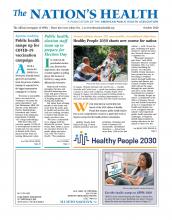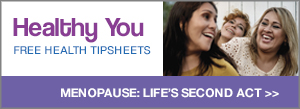
For safety during the pandemic, people are encouraged to vote early if they can, and to wear masks when voting in person.
Photo by Adamkaz, courtesy iStockphoto
In a regular presidential election year, Election Day might mean a line of people crowded together at polling places. But because of COVID-19, voting will be different this November.
Masked poll workers, plexiglass barriers and physical distancing measures will greet voters at polling places, all in hopes of keeping people safer during the pandemic.
But rather than advising people to stay home and away from the polls, public health and election officials are working overtime to ensure that people can safely cast their votes.
“We have a responsibility to engage with the democratic process,” Susan Polan, PhD, APHA’s associate executive director for public affairs and advocacy, told The Nation’s Health. “The pandemic does not mean we sit out the election. It underscores the importance of shaping our state and federal governments.”
Even though public health officials had hoped the pandemic would be more contained by Election Day, they have been getting ready just in case. This summer, the Centers for Disease Control and Prevention issued guidance for election officials so they can keep both workers and the public safe. Among its recommendations, the agency called for attention to ventilation, crowd management, physical barriers, floor markings, regular disinfection and mask use. Offering a wide variety of voting options and longer voting periods is associated with lower risks, CDC said.
Because it is a contentious election year, election officials are expecting a high level of voter turnout. Some states have already seen high numbers of voters during primary elections, which generally do not attract large crowds. In Washington’s Aug. 4 state primary, for example, about 1.1 million more ballots were cast this year than in 2016.
“The pandemic does not mean we sit out the election. It underscores the importance of shaping our state and federal governments.”
— Susan Polan
“People are at home, they’re highly interested, and that ballot is just sitting there on their kitchen counter,” Kim Wyman, MPA, Washington’s Secretary of State, told The Nation’s Health. “From civil rights protests and the pandemic, voters are highly motivated.”
For Washington voters, casting a ballot is easier than in most other states, especially during the pandemic. Washington enacted statewide vote-by-mail elections in 2011. Only Colorado, Hawaii, Oregon and Utah have similar systems in place.
Without financial assistance from the federal government, Wyman says that the limited time states have had to implement new systems for the pandemic is concerning.
“It was apparent that traditional in-person voting was not going to work,” she said.
To further help Americans stay safe as they vote this year, public health and election officials teamed up for We Can Vote, which promotes safe voting practices. APHA is a leading member of the coalition, which was founded in March.
“Millions of people will be voting in a new way this year,” Jessica Barba Brown, We Can Vote senior advisor, told The Nation’s Health. “Changes that usually take years have happened rapidly. These laws don’t change often, and people are bound to be confused.”
We Can Vote offers state-by-state election guides to help people determine how they can vote. The guides highlight important deadlines and links to state election websites and to a Healthy Voting guide, which offers tips for safely casting a ballot.
“No matter how you vote, there are benefits from following public health guidance,” Lori Tremmel Freeman, MBA, National Association of County and City Health Officials told The Nation’s Health.
NACCHO, which is also a leading member of We Can Vote, often works in partnership with the Medical Reserve Corps. During the upcoming election, corps volunteers are working to improve traffic flow at polls stations and to make voting as contactless as possible.
“If you’re planning a local election, reach out to your local health department as soon as you can — and the sooner, the better,” Freeman said.
Almost all states are offering some form of early voting this year without a required reason. However, confusion about rule changes and the spread of misinformation could mean big crowds showing up at polling stations on Nov. 3.
Even as many states adopt safer voting practices, officials are combating both a pandemic and an infodemic. Concerns about the security of mail voting and the likelihood of an extended vote count mean that communication will be critical.
“We need to set expectations now,” Brown said. “This year, it’s much less like Election Day and much more like ‘election season.’”
One way states have worked to decrease COVID-19 risks is by installing ballot drop boxes. In Washington, voters have historically loved the drop boxes, Wyman said.
“We would have people drive over 40 miles to hand-deliver their ballot,” she said.
For more information on the Healthy Voting guides, visit www.healthyvoting.org.
Voting in person this Election Day? Check out these tips before you go
Voters who head to the polls on Election Day should take precautions to stay safe from COVID-19. The Healthy Voting guide from We Can Vote offers helpful tips.
For example, the coalition recommends bringing your own blue and black ink pens to avoid contact with shared items. But before using them, voters should ask poll workers if they are permitted. Always carry a spare mask and hand sanitizer that you can use between hand-washings.
Where allowed, voting before Nov. 3 is safest. Check with your local election office to see if early voting options are available. Polling places are generally not as busy in mid-morning or early-afternoon.
Taking personal transportation or walking will be the safest way to get to the polls. If you are using shared transportation, wear a mask and keep as much distance as possible from others in the vehicle.
Once you get to the polls:
• Follow signs and markers that promote safe distancing and traffic flow.
• Practice physical distancing and stay six feet away from other voters and poll workers when possible. Direct interactions with poll workers should be kept as brief as possible.
• Avoid touching your mask or face.
• Wash your hands before and after voting.
If you’re feeling sick on Election Day, show symptoms of COVID-19 or know you have been exposed, call your local board of elections office and ask what your options are.
For more tips, visit www.healthyvoting.org.
- Copyright The Nation’s Health, American Public Health Association












